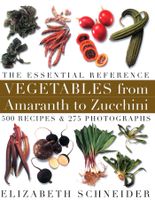Also haricot or kidney bean
The common bean of commerce, the native American Phaseolus vulgaris, is not just a bean but a world of beans, embracing almost everything we call “bean”—from yellow wax to black turtle, from green (snap or string bean) to dried. The remarkable scope and multiple forms of this New World bean have made it among the most difficult plants to classify in either scientific or common terms.
For the common terms, one simplified example from The Oxford Companion to Food should suffice. As Alan Davidson recounts, when Europeans arrived in America, countless varieties of Phaseolus vulgaris with local names had already been cultivated for millennia in North and South America. But the “first samples . . . to reach Europe, in the 16th century, were of a dark red, kidney-shaped variety, so giving rise to the common English name kidney beans.” In France, the bean landed with its “Aztec name, ayecotl, [which] was soon corrupted to haricot, a name which already had another meaning (a meat ragout) and another derivation (from harigoter, to cut up). This usage spread to England, with curious consequences; in the 18th century a dish might be called ‘arrico of kidney beans.’ ”



